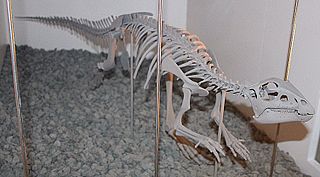
Hypsilophodontidae is a traditionally used family of ornithopod dinosaurs, generally considered invalid today. It historically included many small bodied bipedal neornithischian taxa from around the world, and spanning from the Middle Jurassic until the Late Cretaceous. This inclusive status was supported by some phylogenetic analyses from the 1990s and mid 2000s, although there have also been many finding that the family is an unnatural grouping which should only include the type genus, Hypsilophodon, with the other genera being within clades like Thescelosauridae and Elasmaria. A 2014 analysis by Norman recovered a grouping of Hypsilophodon, Rhabdodontidae and Tenontosaurus, which he referred to as Hypsilophodontia. All other analyses from around the same time have instead found these latter taxa to be within Iguanodontia.
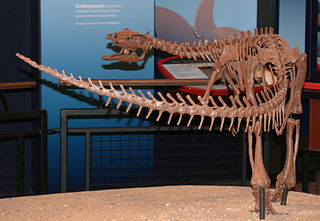
Thescelosaurus was a genus of neornithischian dinosaur that appeared at the very end of the Late Cretaceous period in North America. It was a member of the last dinosaurian fauna before the Cretaceous–Paleogene extinction event around 66 million years ago. The preservation and completeness of many of its specimens indicate that it may have preferred to live near streams.

Animantarx is a genus of nodosaurid ankylosaurian dinosaur from the Early and Late Cretaceous of western North America. Like other nodosaurs, it would have been a slow-moving quadrupedal herbivore covered in heavy armor scutes, but without a tail club. The skull measures approximately 25 cm in length, suggesting the animal as a whole was no more than 3 meters long.
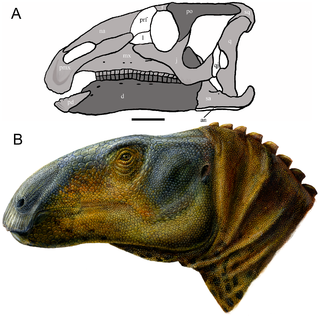
Eolambia is a genus of herbivorous hadrosauroid dinosaur from the early Late Cretaceous of the United States. It contains a single species, E. caroljonesa, named by paleontologist James Kirkland in 1998. The type specimen of Eolambia was discovered by Carole and Ramal Jones in 1993; the species name honors Carole. Since then, hundreds of bones have been discovered from both adults and juveniles, representing nearly every element of the skeleton. All of the specimens have thus far been found in Emery County, Utah, in a layer of rock known as the Mussentuchit Member of the Cedar Mountain Formation.
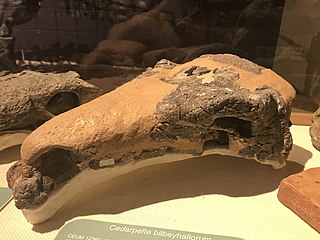
Cedarpelta is an extinct genus of basal ankylosaurid dinosaur from Utah that lived during the Late Cretaceous period in what is now the Mussentuchit Member of the Cedar Mountain Formation. The type and only species, Cedarpelta bilbeyhallorum, is known from multiple specimens including partial skulls and postcranial material. It was named in 2001 by Kenneth Carpenter, James Kirkland, Don Burge, and John Bird. Cedarpelta has an estimated length of 7 metres and weight of 5 tonnes (11,023 lbs). The skull of Cedarpelta lacks extensive cranial ornamentation and is one of the only known ankylosaurs with individual skull bones that are not completely fused together.

Oryctodromeus was a genus of small orodromine thescelosaurid dinosaur. Fossils are known from the Late Cretaceous Blackleaf Formation of southwestern Montana and the Wayan Formation of southeastern Idaho, USA, both of the Cenomanian stage, roughly 105-96 million years ago. A member of the small, presumably fast-running herbivorous family Thescelosauridae, Oryctodromeus is the first non-avian dinosaur published that shows evidence of burrowing behavior.
The Cedar Mountain Formation is the name given to a distinctive sedimentary geologic formation in eastern Utah, spanning most of the early and mid-Cretaceous. The formation was named for Cedar Mountain in northern Emery County, Utah, where William Lee Stokes first studied the exposures in 1944.

Peloroplites is a monospecific genus of nodosaurid dinosaur from Utah that lived during the Late Cretaceous in what is now the Mussentuchit Member of the Cedar Mountain Formation. The type and only species, Peloroplites cedrimontanus, is known from a partial skull and postcranial skeleton. It was named in 2008 by Kenneth Carpenter and colleagues. Peloroplites was 6 metres long and weighed 2 tonnes, making it one of the largest known nodosaurids, and came from a time when ankylosaurids and nodosaurids were attaining large sizes.

The Wayan Formation is a geological formation in Idaho whose strata date back to the latest Early Cretaceous and the earliest Late Cretaceous. Dinosaur, other reptile, mammal, and micro and macro-floral remains are among the fossils that have been recovered from the formation. The lack of extensive outcrops, limited geographic extent, and extreme structural deformation have limited paleontological explorations of the Wayan.

Dakotasuchus is a genus of goniopholidid mesoeucrocodylian. Its fossils have been recovered from the Cenomanian-age Upper Cretaceous Dakota Sandstone of Kansas. The type specimen was found in an iron-cemented sandstone concretion near Salina. This concretion was broken into two large pieces; more of the specimen was probably present originally, but by the time it was found only the torso and short portions of the neck and tail remained. Twenty pairs of bony scutes ran down the midline of the back. The vertebrae lacked the procoelous articulation of more derived crocodyliforms. Dakotasuchus had short broad shoulder blades, suggesting it had stout powerful forelimbs and perhaps terrestrial habits. M. G. Mehl, who described the genus, estimated the length of the type individual when complete to have been 3–4 metres (9.8–13.1 ft). The type species is D. kingi, named for Professor King, a former dean of Kansas Wesleyan University. Mehl did not classify his new genus to a more inclusive group than Mesosuchia. Robert Carroll assigned Dakotasuchus to Goniopholididae in 1988. In 2017, fossils of Dakotasuchus kingi which consisted of a coracoid, scutes, a dorsal vertebrate and postcranial bones were found in Utah, specifically in the Cedar Mountain Formation's Mussentuchit Member.

Thescelosauridae is a clade of neornithischians from the Cretaceous of East Asia and North America. The group was originally used as a name by Charles M. Sternberg in 1937, but was not formally defined until 2013, where it was used by Brown and colleagues as the group uniting Thescelosaurus and Orodromeus, based on their phylogenetic results. During a phylogenetic revision of neornithischians by Clint Boyd in 2015, the authorship of Thescelosauridae was given to Brown and colleagues, which meant that the similar name Parksosauridae, informally defined in 2002 by Buchholz, would have had priority over Thescelosauridae. The two clades had slightly different definitions, with Parksosauridae referring to all animals closer to Parksosaurus than Hypsilophodon, but they contained the same taxa so Boyd used Parksosauridae under the assumption it had priority. However, in formalizing the clade following the regulations of the PhyloCode, Madzia, Boyd, and colleagues identified in 2021 that Sternberg was the proper authority for Thescelosauridae, giving it priority over Parksosauridae. As well, they gave Thescelosauridae the definition of the largest clade containing Thescelosaurus neglectus but not Iguanodon bernissartensis, as long as Hypsilophodon foxii was not in the group, modifying previous definitions for Thescelosauridae in order to maintain its modern use, so that the clade was not applied if Thescelosaurus fell within Hypsilophodontidae, a family that has not been recently used but may be revived if the systematic position of Hypsilophodon was solidified at some point in the future. Madzia et al. identified the analysis of Madzia et al. in 2018 as the reference analysis for the name Thescelosauridae, an analysis based on a revised version of the 2015 Boyd analysis.

Xiongguanlong is an extinct genus of tyrannosauroid theropod from the Early Cretaceous period of what is now China. The type and only species is X. baimoensis. The generic name comes from Jiayuguan City and the Mandarin word "long" which means dragon. The specific epithet, "baimoensis" is a latinization of the Mandarin word for "white ghost" in reference to one of the geological features of the type locality.

Koreanosaurus is a genus of orodromine neornithischian dinosaur. One species has been described, Koreanosaurus boseongensis.

Haya is an extinct genus of basal neornithischian dinosaur known from Mongolia.
Talos is an extinct genus of carnivorous bird-like theropod dinosaur, an advanced troodontid which lived during the late Cretaceous period in the geographic area that is now Utah, United States.

Siats (/see-ats/) is an extinct genus of large theropod dinosaur known from the Late Cretaceous Cedar Mountain Formation of Utah, United States. It contains a single species, Siats meekerorum. It was initially classified as a megaraptoran, a clade of large theropods with very controversial relationships. Siats may be a neovenatorid allosauroid, a coelurosaur of uncertain phylogenetic position, or a tyrannosauroid.
Lindsay E. Zanno is an American vertebrate paleontologist and a leading expert on theropod dinosaurs and Cretaceous paleoecosystems. She is the Head of Paleontology at the North Carolina Museum of Natural Sciences and an Associate Research Professor in the Department of Biological Sciences at North Carolina State University.

Moros is a genus of small tyrannosauroid theropod dinosaur that lived during the Late Cretaceous period in what is now Utah. It contains a single species, M. intrepidus. Moros represents one of the earliest known diagnostic tyrannosauroid material from North America.
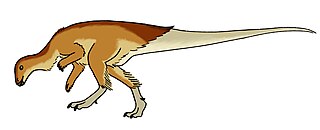
Nevadadromeus is an extinct genus of small thescelosaurine ornithischian dinosaur, from the Willow Tank Formation of Nevada, United States. The genus contains a single species, N. schmitti, which represents the first non-avian dinosaur named from Nevada.
Iani is an extinct genus of rhabdodontomorph iguanodontian dinosaur from the Late Cretaceous Cedar Mountain Formation of Utah, United States. The genus contains a single species, I. smithi, known from a partial skeleton including the skull. Its discovery serves as a link between the genus Tenontosaurus and the Rhabdodontidae, with both along with Iani being members of the clade Rhabdodontomorpha.















